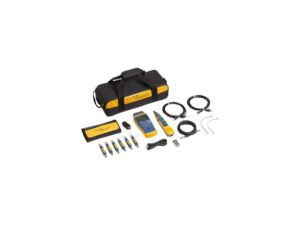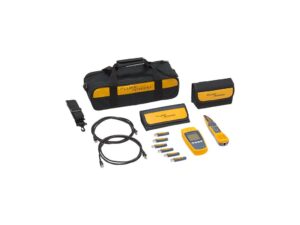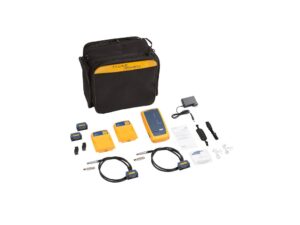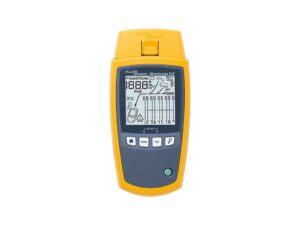Fluke Networks JR-SYS-2 JACKRAPID PunchDown Tool
$108.58
Jackrapid PunchDown Tool
For SYSTIMAX MGS400, MGS500, MFP420, MFP520
Unique design easily accommodates close-to-wall installation
Replaceable blade head for use with multiple jack types
Cuts installation time – easy to use handle, seats and cuts all wires at once, saving you up to 1 minute installation time per jack!
High quality, consistent terminations – no more compromised connections and wasted jacks
Simple, one-handed operation with an ergonomically designed handle reduces hand fatigue
Fluke Networks® JR-SYS-2 JACKRAPID PunchDown Tool for SYSTIMAX MGS400, MGS500, MFP420, MFP520
Reduces installation time
Accurate, clean and consistent cuts and terminations
Eliminates user fatigue
Future Proof
Wall-friendly
Overview
Introducing the new JackRapid, jack termination tool – the industry’s most innovative and time-saving termination tool. This patented tool seats and terminates all wires simultaneously, with one squeeze of the ergonomic handle. Get accurate terminations and clean, consistent cuts every time.
JackRapid™ is a patented jack termination tool that saves time and increases accuracy by seating and terminating all wires at once with a simple squeeze of the handle. JackRapid allows you to terminate jacks eight times faster than traditional impact tools – with accuracy that’s unmatched.
The patented jack termination tool seats and terminates all wires simultaneously. The built-in blade cuts off the excess wire after it is seated in the connector, eliminating the need for a secondary trim step.
Simple, one-handed operation, with an ergonomically designed handle, reduces hand fatigue. With JackRapid, you’ll never punch into the palm of your hand or through drywall again.
Perfect terminations are easy with JackRapid – 7 easy steps
Get accurate terminations and clean, consistent cuts every time with the JackRapid Termination Tool.
1. Strip cable jacket with a standard cable stripper or the built-in cable stripper.
2. Determine wiring scheme. Dress all 4 pairs (8 wires).
3. Insert jack in JackRapid front first with IDC slots facing blades of JackRapid.
4. Ensure jack is completely and securely inserted in jack holder bed with IDC slots facing the blades.
5. Pull trigger completely and remove excess wire prior to releasing trigger.
6. Wires will be seated and cut for a solid termination.
7. Release handle and remove jack from JackRapid tool. Visually verify proper termination.
Learn About Cable Installation Tools
Using the correct termination tool can increase your productivity by enabling you to install Cat 5(e) jacks six to eight times faster. Punchdown tools increase accuracy and reliability, resulting in fewer reworks, which increases client confidence.
There are three types of punchdown tools used to terminate telecommunications cables: manual, impact, and multi-wire. When any conductor is punched down, force is required to seat the conductor. That power can be derived from one of two methods; by human power by which an installer will use his hand or arm to generate the force to seat the conductor using a non-impact tool, or by the use of an impact tool.
The basic impact tool has a spring-loaded head, which is compressed by the installer with very little force required. Once the spring reaches full compression, it is automatically released and the force is transferred to the head of the impact tool, which then seats the conductor. Advanced multi-wire tools such as JackRapid terminate all pairs with one squeeze, reducing hand fatigue.
Most impact tools can be fitted with a number of interchangeable blades, depending on the cabling system you are using. The advantages of an impact tool are speed, ease of use, and consistency of termination. The tool will help you push each wire into the slot to make a permanent connection. Advanced punchdown tools have a built-in blade that cuts off the excess wire after the wire is pushed onto the connector; others may require you to snip that off with the wire cutters, creating another step.
Newer punchdown tools offer an ergonomic, easy-to-use handle and a built-in bed that helps hold the jack in place. Other new features include replaceable blade head for use with multiple jack types and wall-friendly designs to accommodate close-to-wall installations.
To use an advanced punchdown tool, you first determine the wiring scheme is in place, strip the cable jacket, place the eight wires in their respective slots, and then insert the jack in the tool. After the trigger is pulled completely, the wires will be seated and cut for a solid termination. The handle is then released and the jack is removed from the tool. After visually verifying the proper termination, you follow the standard dress and press procedures. The combination of faster, more reliable terminations and less rework can cut the cost of this portion of the installation job by as much as 80%.
In addition to tool kits and punchdown tools, many other hand tools aid in cable installation. Professional scissors are important for a fast, clean, and safe cut. You will need to cut cable and trim excess wires on every job. Some specialty tools offer a unique ergonomically-designed handle that leverages your power, providing 1 ½ times the cutting force with half the effort. The special “tail” on the handle that provides the added leverage also minimizes hand fatigue. Also, a cable stripper with an adjustable gauge is necessary for any cabling job. A high-quality cable stripper will guarantee fast, easy removal of outer insulation from all unshielded twisted pair, shielded twisted pair and multi-core cables. An adjustable depth gauge and a reference for checking the length to be stripped will ensure highly repeatable results and improve the quality of work. Using alternative methods like a pocket knife or scissor could result in stripping more cable sheath than necessary and damaging the cable itself. Other useful tools during cable installation include crimping pliers, cable splicing knives, can wrenchesfor access to telephone boxes and pedestals, voltage detectors for protection against hazardous voltages, modular crimpers for telephone plugs, and probe pics to check for loose or damaged connections.
After installation, the job must be tested and delivered to the customer. Handheld test instruments(better known as test tools) vary tremendously in price, performance, and application. Depending on what task the test tool performs, they can be classified into broad hierarchical groups of verification, qualification, or certification. Basic verification test tools can help you look for basic wiring faults such as miswires, opens, shorts, and split pairs after cable installation. However, if you want to offer a warranty backed by the cable manufacturer, you need to use a certification tool approved by the manufacturer. Anything else puts the sole warranty responsibility on you. For more information on each of these classes of testers and what testers and testing applies to your needs after cable installation, please continue to the cable testing page.







Reviews
There are no reviews yet.